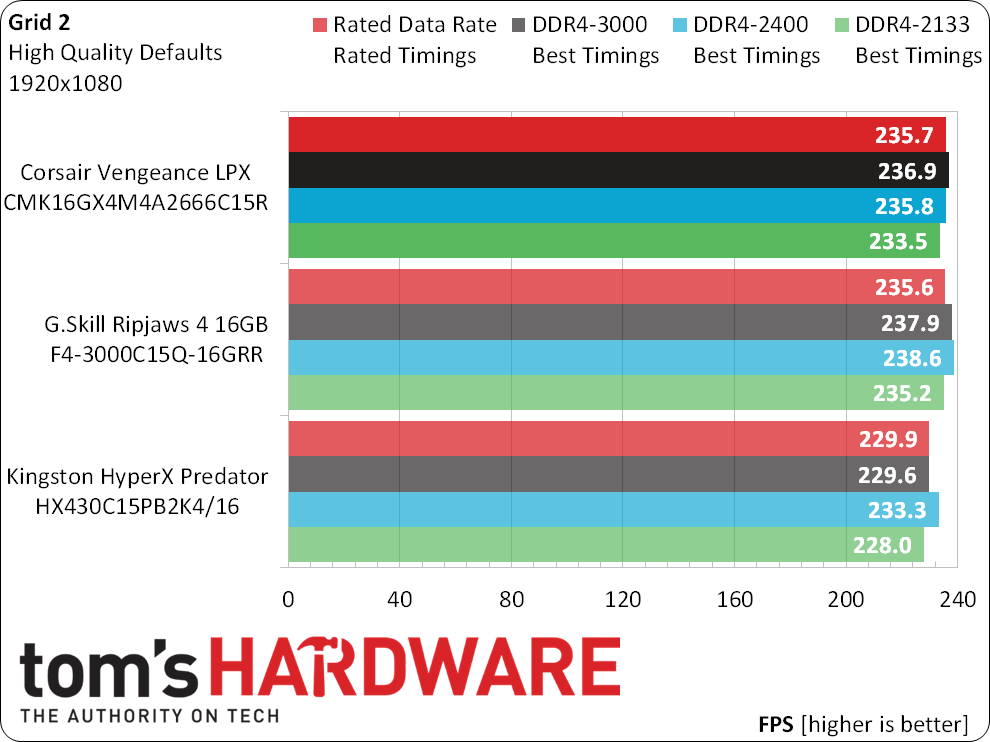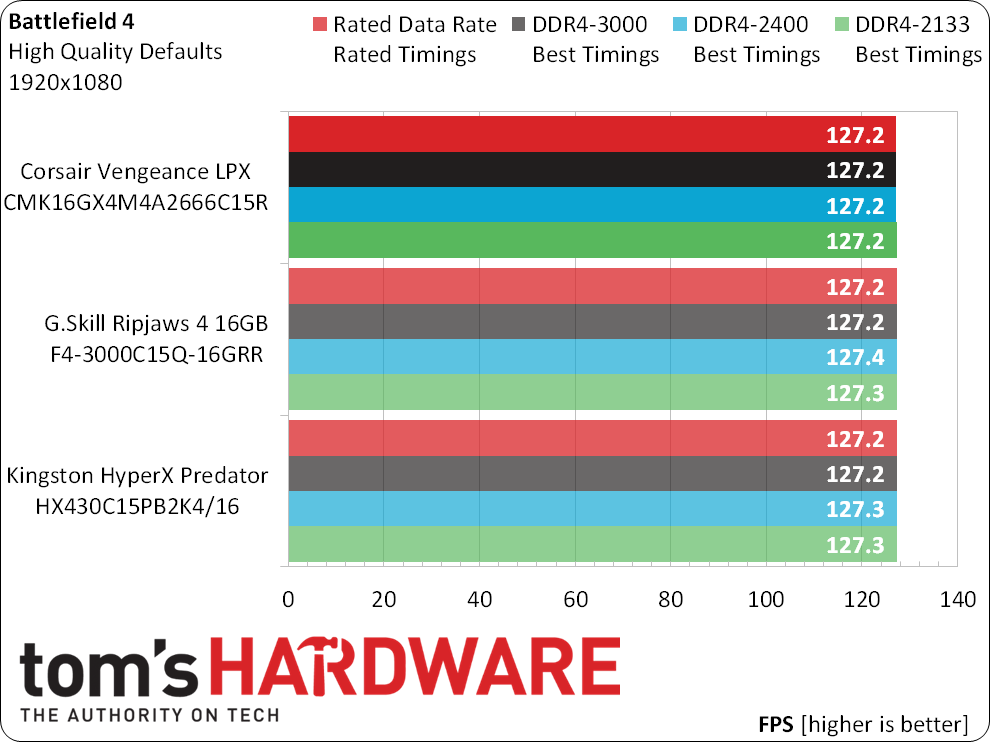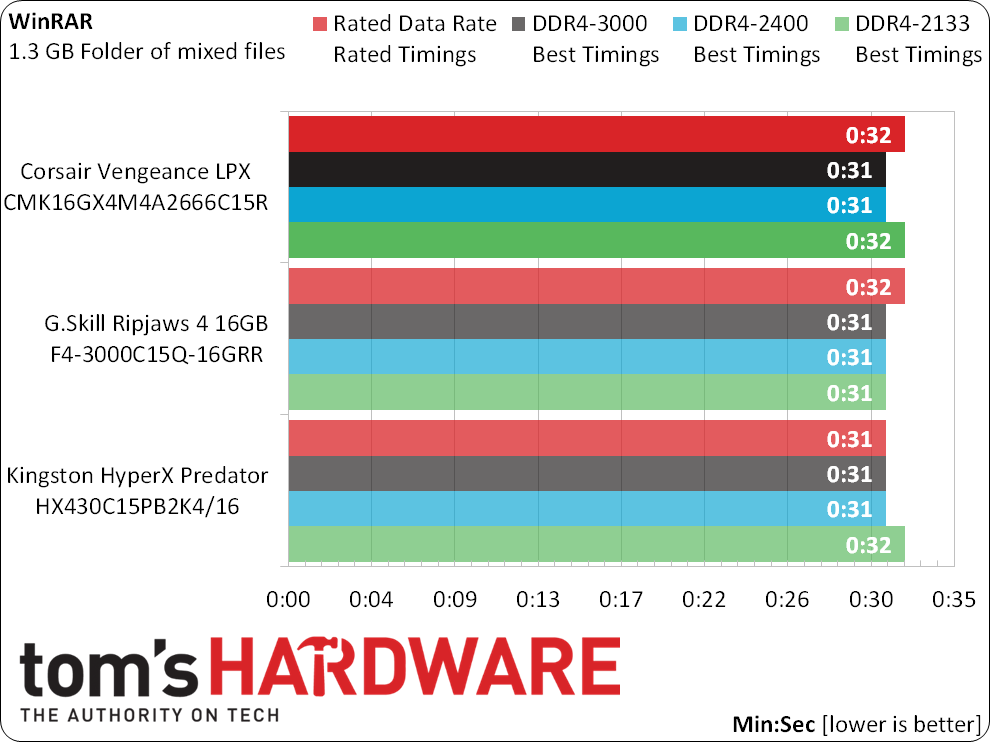Corsair Vengeance LPX DDR4-2666 Review
Why you can trust Tom's Hardware
Real World Benchmarks, Value And Recommendations
Corsair’s Vengeance LPX DDR4-2666 edges out Kingston’s DDR4-3000 across Grid 2, likely in part reflecting its ability to support ever-so-slightly tighter latencies.
A miniscule 0.4FPS represents the entire range of Battlefield 4 results I’ve seen in all of my DDR4 tests, owing mostly to its graphics card dependence. That still represents recent high-end AAA games more accurately, though. While performance difference can occasionally be attributed to other parts of the machine, I usually remember to disregard deltas this small.
Similarly, our timed benchmark can vary by a few thousandths of a second per run, which causes the number of seconds to round differently. These benchmarks are somewhat bandwidth-sensitive, but not to the extent that this can be revealed in such closely-matched configurations. When no two-second differences exist, I generally find these to be a buffer in the overall performance charts.
To this point, we’ve seen Corsair’s Vengeance LPX DDR4-2666 kit beat Kingston’s DDR4-3000 in tests from overclocking to gaming. That means a lot from a kit that’s given a lower-rated frequency by its producer. But these two are close enough that the cheaper parts will win.
Here’s where we see the other benefit of Corsair’s lower frequency rating. Without the fancy sinks and sensors on the company's highest-priced models, consumers expect to pay less for Vengeance LPX DDR4-2666 than they would for HyperX Predator DDR4-3000. Corsair obliges, with an almost-affordable price of $325 (compared to the Predator’s $370).
Afterthought: Google Shopping appears to be taking on Bing’s “decision engine” concept, showing the parts it thinks you should want rather than the parts you’re actually searching for, after entering part number CMK16GX4M4A2666C15R. We found these for $325 at Newegg.
Get Tom's Hardware's best news and in-depth reviews, straight to your inbox.
Current page: Real World Benchmarks, Value And Recommendations
Prev Page Overclocking, Tuning, Bandwidth And Latency-
blackmagnum I have to ask: Do these aluminum clip-on heat spreaders help with lowering the temperature or they just like huge spoilers on Honda Civics (I look fast)?Reply -
COMONGUISE I have to ask - When will Tom's show a comparison with DDR3? I know its on a different chipset, but we would really like to know.Reply -
SuperVeloce @tom10167: Well yeah, 1600 ram is enough for 99% home usage scenarios, no matter how much faster a DDR4 can be. But now you can already get 2666 cl15 ram (latency something like ddr3 1600mhz cl7, cl8), and if that's at 1,2V, even better. First ddr3 ram sticks for first amd ddr3 chipsets and core2 intels were terrible and with high voltage for faster models (I even saw 1,7V+). So in a way this time around latency drops faster and it's not even available yet in mainstream platforms...Reply -
Crashman Reply
Different processors make an inaccurate comparison, but you can compare two articles if you like. In fact we used the same benchmarks so that you could.15173990 said:I have to ask - When will Tom's show a comparison with DDR3? I know its on a different chipset, but we would really like to know.
On the other hand, comparing two articles to prove that DDR4 currently performs slightly worse than DDR3 is a futile task. Anyone who buys LGA 2011-v3 does so for its added PCIe lane OR added CPU cores. They have no choice other than DDR4.
Right, go ahead and pair DDR3 with your Core i7-5930k. Tell us how it goes. Thanks.15174259 said:They won't do that because then nobody would buy any DDR4 ram -
codo everything on my machine is blitzing as it should be but just cause I know this exists I want it.Reply -
CaedenV ReplyI have to ask: Do these aluminum clip-on heat spreaders help with lowering the temperature or they just like huge spoilers on Honda Civics (I look fast)?
To say that it did not help at all would be a lie... but it is mostly for looks.
I have to ask - When will Tom's show a comparison with DDR3? I know its on a different chipset, but we would really like to know.
When Skylake comes out we should see the first chips that can support DDR3 and DDR4 so we can see some true head-to-head comparisons. I suspect that DDR4 is (at least at the moment) no better than DDR3 in performance and only has an advantage in a performance per watt perspective. But like Crashman said: The first DDR3 modules (and controllers) were horrible and no better than DDR2 at the time. At least DDR4 is improving faster, and dropping in price sooner, than DDR3 did.
-
DDR4 is a bad joke right now. Kits are expensive, slow and low capacity. Where are the 16GB sticks? Timings of 15-15-15-35-2T?Reply





